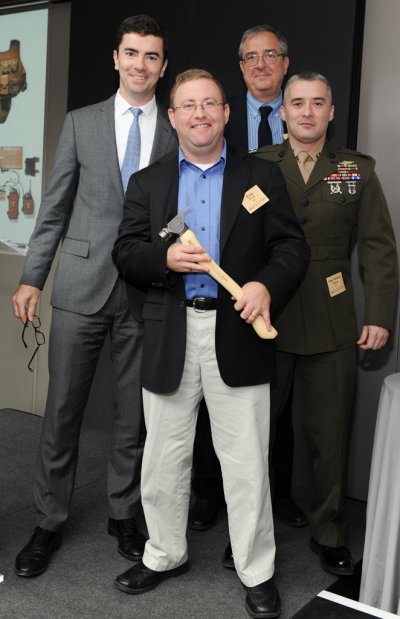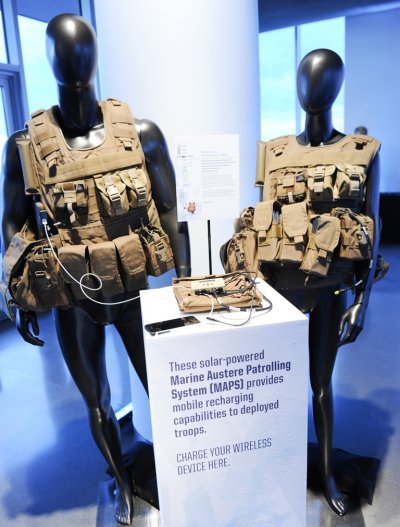
Ryan D'Agostino, editor-in-chief at Popular Mechanics; Eric South, Naval Surface Warfare Center Dahlgren Division lead electrical engineer for the Marine Austere Patrolling System (MAPS); Phillip Jenkins, Naval Research Laboratory MAPS solar scientist; Marine Capt. Anthony Ripley, science and technology lead at the U.S. Marine Corps Expeditionary Energy Office are pictured (left to right) at the Popular Mechanics Breakthrough award ceremony in New York, Oct. 7. South, Jenkins and Ripley were honored for their role in developing MAPS as an individual, wearable power management and distribution system, enabling Marines to patrol longer without resupply. Photo by Sean Sime, courtesy Popular Mechanics.
NEW YORK, N.Y. (Oct. 22, 2014)—A Navy civilian engineer based in Virginia and two of his Marine Austere Patrolling System (MAPS) colleagues received a Popular Mechanics Breakthrough Award at a New York ceremony, Oct. 7.
Popular Mechanics honored Eric South - the Naval Surface Warfare Center Dahlgren Division lead electrical engineer for MAPS - for his role in developing the system as an individual, wearable power management and distribution system, enabling Marines to patrol longer without resupply.
"It was an honor to participate in the Breakthrough Awards ceremony and to interact with groundbreaking scientists and engineers across the country," said South. "MAPS is a project that focuses on the idea of sustaining the power, energy, and water of dismounted troops. It's a culmination of government and contractor efforts, and we work very closely with Marines. Their direct feedback is what goes into the system design and improvement."
South collaborates on MAPS with Marine Capt. Anthony Ripley, science and technology lead at the U.S. Marine Corps Expeditionary Energy Office, and Phillip Jenkins, Naval Research Laboratory MAPS solar scientist, who were also honored at the gala event.
"I was proud to accept the 2014 Popular Mechanics Breakthrough Technology of the Year Award for the Marine Austere Patrolling System (MAPS) on behalf of the Marine Corps Expeditionary Energy Office Team," said Ripley. "It was the culmination of many years of effort and collaboration between multiple organizations."
The system features an advanced solar panel and a water filtration system. It integrates flat-form batteries and provides a central source of electrical energy that can be adapted to any equipment's electrical requirements.

The Marine Austere Patrolling System (MAPS) on display at the Popular Mechanics Breakthrough awards ceremony in New York, Oct. 7. MAPS - a solar-energy harvesting and storage system combined with an individual water-purification unit - significantly reduces the physical burden and increases the efficacy of deployed troops who rely increasingly on battery-powered combat and communications equipment. Photo by Sean Sime, courtesy Popular Mechanics.
Common electronics the vest can power for Marines include gear such as radios, night-vision goggles, global positioning system, laptops and universal serial bus powered equipment.
"Marines' direct feedback is what goes into the system design and improvement," said South. "We are now partnering with OSD (Office of the Secretary of Defense) and the U.S. Army on next generation MAPS concepts. One day, Marines and Soldiers will be able to filter water on the move. Since they'll be able to generate, store, and manage their own power, warfighters won't have to carry around so many batteries. We will be able to extend our missions and lethality without relying as much on re-supply. That is why Popular Mechanics awarded MAPS a breakthrough award - and we're not done yet."
The next evolution of MAPS is called the Joint Infantry Company Prototype.
"The Joint Infantry Company Prototype will push the envelope further by integrating wearable systems that generate power from Marines' movement," said Ripley. "In the future, a MAPS-like system will sustain dismounted Marines during multi-day operations and reduce the need for energy and water re-supply in austere environments."
In addition to South, Ripley and Jenkins, Popular Mechanics honored inventors of the world's first 3D-printed car, and a premade skyscraper. High school and middle school students were also recognized with the magazine's Next Generation Award for achievements that will help improve lives of the visually impaired, aging society, and more.
"For ten years, the Breakthrough Awards have unearthed and honored some of the most important innovations in America," said Ryan D'Agostino, editor-in-chief of Popular Mechanics. "This year, for the first time, we focus entirely on achievements that are having an immediate impact on our culture - the people, things, and ideas that are making a real difference right now. We are honored to be able to tell the world about them."
MAPS is being developing for the Marine Expeditionary Energy Office and directly supports the USMC Expeditionary Energy Strategy and Implementation Plan to, "deploy Marine Expeditionary Forces that can maneuver from the sea and sustain C4I (command, control, computers and intelligence) and life support systems in place."


